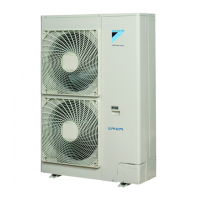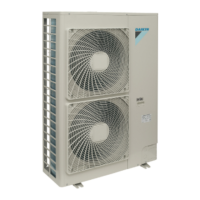Do you have a question about the Daikin ERSQ016AAV1 and is the answer not in the manual?
Provides an overview of the Daikin ERSQ/ERRQ outdoor heat pump units.
Details the manual's coverage of unpacking, installation, and connection procedures for outdoor units.
Explains how to identify different Daikin outdoor unit models based on their codes.
Guidelines for choosing an appropriate and safe site for the outdoor unit installation.
Important safety precautions and considerations during the unit installation process.
Details unit dimensions and required clearances for installation and maintenance access.
Procedures for safe inspection, handling, and unpacking of the outdoor unit.
Instructions for correct drain piping installation to ensure proper water drainage.
Step-by-step guidance for the physical installation of the outdoor unit.
Guidance on selecting appropriate materials for refrigerant piping to ensure system integrity.
Specifies the correct pipe sizes for gas and liquid refrigerant lines for optimal flow.
Details maximum pipe lengths and height differences for optimal system performance.
Explains when and where to install oil traps in the refrigerant piping to ensure oil return.
Procedures and precautions for brazing refrigerant pipes, emphasizing nitrogen purging.
Instructions for making secure and leak-free flare connections for refrigerant piping.
Proper procedures for handling stop valves and their components to prevent damage.
Details on installing refrigerant piping in various directions, including knockout hole usage.
Methods to prevent debris and foreign objects from entering piping during installation.
Procedures for performing leak tests and vacuum drying on the refrigerant system.
Precautions for connecting field piping and applying proper insulation to prevent condensation.
Details about the R410A refrigerant, its properties, and environmental considerations.
Tables and instructions for calculating the required additional refrigerant charge based on pipe length.
Step-by-step guide on how to correctly charge refrigerant into the system.
Safety warnings and guidelines for performing electrical wiring safely and correctly.
A table listing internal electrical components and their corresponding part codes.
Diagram illustrating the system's field wiring connections for clarity.
Precautions for wiring power supply and inter-unit connections.
How to safely create knock-out holes for wiring and prevent rust damage.
Details on standard electrical components used in the unit.
Guidelines for safely routing and installing power wiring.
Instructions for connecting control wiring between units.
Checklist of essential checks to perform before powering on the unit.
A comprehensive checklist for final verification of installation before unit operation.
Procedure for conducting test runs to ensure all functions and parts operate correctly.
General safety warnings and precautions to be observed during maintenance and servicing.
Instructions on how to operate the unit in service modes for diagnostics and adjustments.
Provides an overview of the Daikin ERSQ/ERRQ outdoor heat pump units.
Details the manual's coverage of unpacking, installation, and connection procedures for outdoor units.
Explains how to identify different Daikin outdoor unit models based on their codes.
Guidelines for choosing an appropriate and safe site for the outdoor unit installation.
Important safety precautions and considerations during the unit installation process.
Details unit dimensions and required clearances for installation and maintenance access.
Procedures for safe inspection, handling, and unpacking of the outdoor unit.
Instructions for correct drain piping installation to ensure proper water drainage.
Step-by-step guidance for the physical installation of the outdoor unit.
Guidance on selecting appropriate materials for refrigerant piping to ensure system integrity.
Specifies the correct pipe sizes for gas and liquid refrigerant lines for optimal flow.
Details maximum pipe lengths and height differences for optimal system performance.
Explains when and where to install oil traps in the refrigerant piping to ensure oil return.
Procedures and precautions for brazing refrigerant pipes, emphasizing nitrogen purging.
Instructions for making secure and leak-free flare connections for refrigerant piping.
Proper procedures for handling stop valves and their components to prevent damage.
Details on installing refrigerant piping in various directions, including knockout hole usage.
Methods to prevent debris and foreign objects from entering piping during installation.
Procedures for performing leak tests and vacuum drying on the refrigerant system.
Precautions for connecting field piping and applying proper insulation to prevent condensation.
Details about the R410A refrigerant, its properties, and environmental considerations.
Tables and instructions for calculating the required additional refrigerant charge based on pipe length.
Step-by-step guide on how to correctly charge refrigerant into the system.
Safety warnings and guidelines for performing electrical wiring safely and correctly.
A table listing internal electrical components and their corresponding part codes.
Diagram illustrating the system's field wiring connections for clarity.
Precautions for wiring power supply and inter-unit connections.
How to safely create knock-out holes for wiring and prevent rust damage.
Details on standard electrical components used in the unit.
Guidelines for safely routing and installing power wiring.
Instructions for connecting control wiring between units.
Checklist of essential checks to perform before powering on the unit.
A comprehensive checklist for final verification of installation before unit operation.
Procedure for conducting test runs to ensure all functions and parts operate correctly.
General safety warnings and precautions to be observed during maintenance and servicing.
Instructions on how to operate the unit in service modes for diagnostics and adjustments.











